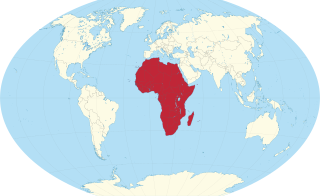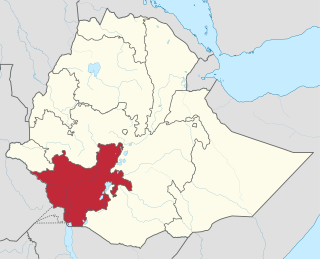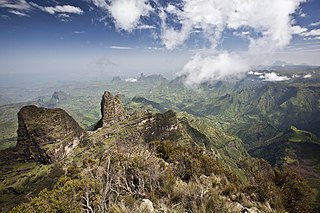Related Research Articles

Africa is a continent comprising 63 political territories, representing the largest of the great southward projections from the main mass of Earth's surface. Within its regular outline, it comprises an area of 30,368,609 km2 (11,725,385 sq mi), excluding adjacent islands. Its highest mountain is Kilimanjaro; its largest lake is Lake Victoria.

Ethiopia is located in the Horn of Africa. It is bordered by Eritrea to the north, Djibouti and Somalia to the east, Sudan and South Sudan to the west, and Kenya to the south. Ethiopia has a high central plateau, the Abyssinian Highlands that varies from 1,290 to 3,000 m above sea level, with some 25 mountains whose peaks rise over 4,000 meters (13,200ft), the highest being Ras Dashen at 4,543 meters (14,538ft).

Lake Turkana is a saline lake in the Kenyan Rift Valley, in northern Kenya, with its far northern end crossing into Ethiopia. It is the world's largest permanent desert lake and the world's largest alkaline lake. By volume it is the world's fourth-largest salt lake after the Caspian Sea, Issyk-Kul, and Lake Van, and among all lakes it ranks 24th.

Lake Abaya is a lake in the Southern Nations, Nationalities, and Peoples' Region of Ethiopia. It is located in the Main Ethiopian Rift, east of the Guge Mountains.

The Southern Nations, Nationalities, and Peoples' Region was a regional state in southwestern Ethiopia. It was formed from the merger of five kililoch, called Regions 7 to 11, following the regional council elections on 21 June 1992. Its government was based in Hawassa.

The Gurage are a Semitic-speaking ethnic group inhabiting Ethiopia. They inhabit the Gurage Zone and East Gurage Zone, a fertile, semi-mountainous region in Central Ethiopia Regional State, about 125 kilometers southwest of Addis Ababa, bordering the Awash River in the north, the Gibe River, a tributary of the Omo River, to the southwest, and Hora-Dambal in the east.

The Omo River in southern Ethiopia is the largest Ethiopian river outside the Nile Basin. Its course is entirely contained within the boundaries of Ethiopia, and it empties into Lake Turkana on the border with Kenya. The river is the principal stream of an endorheic drainage basin, the Turkana Basin.

The Mursi are a Surmic ethnic group in Ethiopia. They principally reside in the Debub Omo Zone of the Southern Nations, Nationalities, and People's Region, close to the border with South Sudan. According to the 2007 national census, there are 11,500 Mursi, 848 of whom live in urban areas; of the total number, 92.25% live in the Southern Nations, Nationalities, and People's Region (SNNPR).

The Alfeiós or Alpheios is the main stream of the Alpheios Valley drainage system, a dendritic type, originating on the north slopes of Mount Taygetus, located in the center of the Peloponnesus of Greece, and flowing to the northwest to the vicinity of Olympia, where it turns to the west and, after being impounded by the Flokas Dam, a hydroelectric facility, empties into the Gulf of Kyparissia of the Ionian Sea south of Pyrgos. The entrance into the gulf through agricultural land and across an unpopulated, sandy beach partially blocked by a spit is hydrologically unspectacular, with the water too shallow to be navigable by any but the smallest craft.

The Ethiopian Highlands is a rugged mass of mountains in Ethiopia in Northeast Africa. It forms the largest continuous area of its elevation in the continent, with little of its surface falling below 1,500 m (4,900 ft), while the summits reach heights of up to 4,550 m (14,930 ft). It is sometimes called the "Roof of Africa" due to its height and large area. It is the only country in the region with such a high elevated surface. This elevated surface is bisected diagonally by the Great East African Rift System which extends from Syria to Mozambique across the East African Lakes. Most of the Ethiopian Highlands are part of central and northern Ethiopia, and its northernmost portion reaches into Eritrea.

The Albertine Rift is the western branch of the East African Rift, covering parts of Uganda, the Democratic Republic of the Congo (DRC), Rwanda, Burundi and Tanzania. It extends from the northern end of Lake Albert to the southern end of Lake Tanganyika. The geographical term includes the valley and the surrounding mountains.

The Mount Meager massif is a group of volcanic peaks in the Pacific Ranges of the Coast Mountains in southwestern British Columbia, Canada. Part of the Cascade Volcanic Arc of western North America, it is located 150 km (93 mi) north of Vancouver at the northern end of the Pemberton Valley and reaches a maximum elevation of 2,680 m (8,790 ft). The massif is capped by several eroded volcanic edifices, including lava domes, volcanic plugs and overlapping piles of lava flows; these form at least six major summits including Mount Meager which is the second highest of the massif.

Halaba is a zone in the Central Ethiopia Regional State. It is named after the Halaba people, and covers part of their homeland. Located in the Great Rift Valley, Halaba zone is bordered on the south by an exclave of Hadiya Zone, on the southwest by the Kembata Tembaro Zone, on the west and north by Hadiya Zone, on the north east by Lake Shala, and on the east by Oromia Region; the Bilate River, which is its major body of water, defines its western boundary. The administrative center is halaba Kulito.
The Bilate is a river of south-central Ethiopia. It rises on the southwestern slopes of Mount Gurage near 6°2′N38°7′E, flowing south along the western side of the Great Rift Valley, to empty into Lake Abaya at 6°37′54″N37°59′6″E. It is the longest river flowing into Lake Abaya and also the one with the highest discharge. The 250 km long river is not navigable and has no notable tributaries. Along the middle of its course, the Bilate flows past the Bilate River volcanic field and its most territory covered by Halaba Zone.
Wabe River is a west-southwest flowing river of south-central Ethiopia, entirely confined within the reaches of Gurage Zone of the Southern Nations, Nationalities, and Peoples' Region.
The Gidabo River is a medium-sized perennial river of south-central Ethiopia within the Great Rift Valley. The Gidabo River catchment area is one of the leading coffee production areas in Ethiopia.

Dimtu or Wolaita Dimtu or Bilate Tena is a town in south-central Ethiopia. It has an elevation between 1,000 and 1,600 metres above sea level. It was part of the former Damot Weyde (Woreda) of Wolayita Zone, near to Sodo Zuria woreda. It is now under the Diguna Fango woreda. Some writers mention the town as Bilate Tena in their books and journals. Among them, Getahun Garedew, former Head Officer in Education Bureau of Southern Nations, Nationalities, and Peoples' Region, and State Minister of Ministry of Education since 2020, is the anterior. In the book "Local Adaptation Practices in Response to Climate Change in the Bilate River Basin, Southern Ethiopia", he used these two names, Dimtu and Bilate Tena, in a similar way.

Ikat Range is a mountain range in Buryatia, Russia. It runs in a parallel direction to the Baikal Rift. The range is named after two small rivers sharing the name "Ikat" which have their sources in opposite slopes of the range one is a tributary of the Gargi and the other a tributary of the Vitimkan.
References
- ↑ Elevation per Ethiopian Mapping Authority. 2010 National Statistics (Abstract): climate, Table A.1. Central Statistical Agency website (accessed 18 March 2011)
- ↑ Google (12 November 2016). "Mount Gurage" (Map). Google Maps . Google. Retrieved 12 November 2016.
- ↑ "Local History in Ethiopia", The Nordic Africa Institute website (accessed 17 March 2011)
- ↑ Billi, Paolo (23 March 2015). Landscapes and Landforms of Ethiopia. Springer. p. 92. ISBN 978-94-017-8026-1.
- ↑ Girma Kebbede (4 October 2016). Environment and Society in Ethiopia. Taylor & Francis. p. 146. ISBN 978-1-315-46427-5.
- ↑ "Bilate River Field". Volcanodiscovery.com. Retrieved 12 November 2016.
- ↑ Olson, James Stuart (1996). The Peoples of Africa: An Ethnohistorical Dictionary. Greenwood Publishing Group. p. 502. ISBN 978-0-313-27918-8.